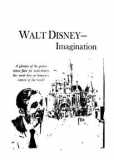
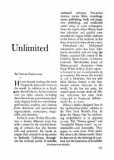
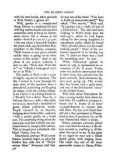
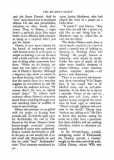
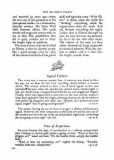
[Condensed version of article "Greatest One-Man Show on Earth," in McCall's, 1964-07, pp.98-101,121]
He has become perhaps the most frequently honoured citizen in the world. In addition to 29 Academy Award Oscars, he has received over 700 other awards, including decorations from governments, honorary degrees from five universities, gold medals, trophies, and citations from American and international organizations, newspapers, magazines and churches.
In his 62 years, Walter Elias Disney — a former Missouri farm boy with a talent for the fanciful drawing of animals — has also become rich and powerful. He heads an empire that extends from his studio in Burbank, California, through out the civilized world. It includes animated cartoons, live-action movies, nature films, recordings, music publishing, book and magazine publishing, and syndicated comic strips in 1,000 newspapers. Since the 1950’s, when Disney burst into television and quickly commanded the largest family audience in the history of the medium, he has done 26 new television shows a year.
Disneyland — the Hollywood amusement park — has been fabulously successful, and not long ago Disney acquired full control of the Celebrity Sports Centre, in Denver, Colorado. Merchandise based on Disney-created characters — from Snow White dolls to Zorro capes — is licensed to 700 manufacturers in 40 countries. His mouse (he wanted to call it Mortimer, but his wife liked Mickey better) is the best-known cartoon character in the world. In the last ten years, the annual gross income from all Disney operations has risen from 11,641,408 to 81,922,127 dollars — nearly Rs. 40 crores.
Disney’s studios designed four of the multimillion-dollar exhibits at the New York World’s Fair. In them the Disney flair for enchanting, make-believe is as apparent as ever. The "Disney genius" and "wonderful Disney touch" are unmistakable — and inimitable. They appear to come from Walt alone. But what is the Disney touch ? Since he does not do the drawing of a cartoon nor the animation of an exhibit with his own hands, what precisely is Walt Disney a genius at?
Well, genius is a complicated thing. Disney is a medium-tall man with big restless hands and eyes that sometimes seem to focus on remote, secret places. He is always at the studio — from 8.30 a.m. to 7.30 p.m. — has not taken a bona-fide holiday for years; and, says his brother Roy, president of the Disney company, "Walt knows at any given minute exactly what is going on – in every corner of this studio." And at any phase of any project, someone is sure to ask, "How does Walt like it?" or, "I think it looks good. Let’s try it on Walt."
The studio is likely to be a scene of highly organized madness. The day I visited it, I saw through the open door of the machine shop a pterodactyl, screeching and flapping its wings, circle the ceiling endlessly on a wire; it was being tested for a World’s Fair exhibit. Near by, a full-size dinosaur, with a silly smile on its face, munched a mouthful of green plastic prehistoric weeds. People careered by on bicycles, dodging what looked like — and was — half a plastic gorilla on a hand cart. The surprising thing about the panorama was that nobody was surprised about it, except a few visitors. This is imagination unlimited — the blood Disney lives by.
Disneyland, perhaps Walt's most famous creation, began as what his Brother Roy calls one of "Walt’s screwy ideas." Everyone told him he was out of his mind. "You want to build an amusement park?" Roy asked. "Not exactly," Walt said. "It’s going to be a – well, it’s sort of a Disneyland." The idea had been cooking in Walt’s brain since the mid-1930’s, when he had begun taking his two young daughters to amusement parks, which he found "dirty, phoney places, run by tough-looking people." None of the customers appeared to be having any fun. "I could see there was a need for something new," he says.
When Disneyland opened its doors in 1955, it represented an investment of Rs. 8 crores. Today, some five million visitors pour nearly three times that amount into the place annually. And attendance figures keep going up. The screwy idea has turned into a gold mine, and one of the best-known "cities" in the United States.
Walt feels about Disneyland the way a young mother feels about her first baby. He coddles it, pampers it, fusses over it, boasts of its latest accomplishments to anyone who will listen. He has even fitted himself out a tiny apartment in Disneyland so that, if necessary, he can be near Disneyland when it sleeps.
Disney possesses curiously gifted eyes – eyes that do not see, in the objects around us, anything at all like what the rest of us see. In the pipes of an organ he once saw a whole choral group with singing faces. The result was one of the most memorable scenes in Snow White and the Seven Dwarfs. And he "sees" more than faces in inanimate objects. He also sees personalities, emotions — in other words, characters. Thus, to Disney, a sugar bowl — a perfectly plain, blue sugar bowl — is an officious little creature, as smug as a corporal who’s just got his stripes.
Disney is even more famous for his knack of endowing animals with human traits. It is not quite as simple as making a cat cut its meat with a knife and fork — which is the sort of thing other cartoonists have done. "When we do fantasy, we must not lose sight of reality," is one of Disney’s maxims. Although a sequence may show an ostrich in toe shoes dancing a ballet, he insists that the ostrich dance in a way that suggests its movements in real life — so that the audience will say, "Of course — that’s the way an ostrich would dance." To achieve such authentic effects, Disney’s animators spend hours prowling through zoos and watching films of wildlife in natural surroundings.
Disney also possesses an ear gifted with the power of hearing how animals talk. To find the right voice for Archimedes, the owl in The Sword in the Stone, Disney’s latest feature length animated cartoon, hundreds of actors were auditioned. Disney wanted Archimedes to talk in the way an owl would talk if an owl could talk. Repeatedly he said that he could "hear" Archimedes’ voice. Then someone mentioned an actor, Junius Matthews, who had played the voice of a potato on a radio show.
"A potato?" said Disney. "Any man who can talk like a potato can talk like an owl. Bring him in." Matthews came in, talked like an owl and was hired.
The elusive Disney touch, then, is not so much a touch as it is a turn of mind – a special way of looking at, listening to, thinking about and "feeling" the people, human or otherwise, with whom he works. Under this turn of mind, all the other more familiar elements’ of drama — whimsy, comic situation, pathos, suspense, surprise — are given a new dimension.
There is an essential wholesomeness about everything Walt Disney does. It has caused him to be labelled corny and an arch-sentimentalist. In his films he is, always a moralist. Virtue in the end triumphs over evil. Love, when it appears, is pure and good. Sex never rears its head, ugly or otherwise. "There’s enough ugliness and cynicism in the world," Disney says, "without me adding to it." He likes to know that parents, seeing his name on a film, have a guarantee that their children will sec nothing off-colour, violent or otherwise untoward.
In the divorce-happy, scandal-mongering world or Hollywood, the Disneys provide a counterweight on the other end of the scale. Lillian Disney, whom Walt met and married 39 years ago — when she was one o£ two animators in his just-opened studio — is a diminutive, cheerful woman. She helps Walt with business affairs. She reads novels and magazine stories with an eye to their film possibilities. But she is quite content not to share the bright light of publicity.
The most serious criticism levelled at Disney is that he absorbs people like a giant sponge — that he takes all the talents and skills of his gifted staff and signs the name "Wait Disney" to them, takes the credit for "creating’’ everything, while the organization does the work. And yet, because everything his organization does is filtered through his eyes, his ears, his taste, hip personality, he is the one who does create. The talents of his men (as they admit themselves) hang suspended in chemical solution; Walt, the catalyst, is added — and it is then that the bright crystals form.
| Id | 3157 |
|---|---|
| Availability | Free |
| Inserted | 2017-03-30 |